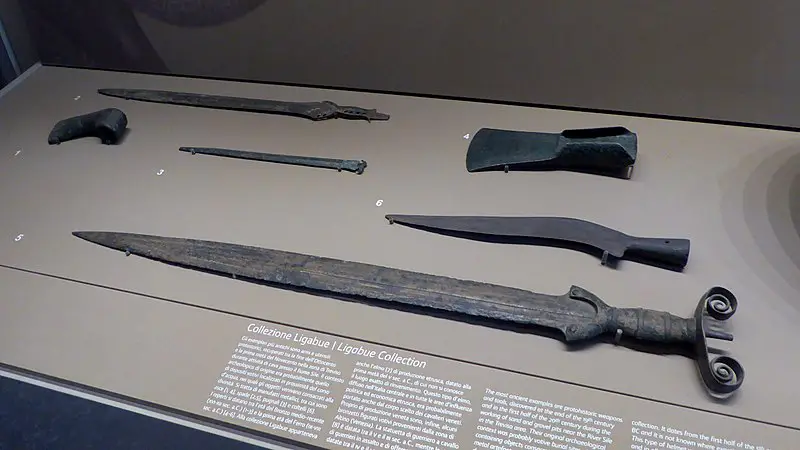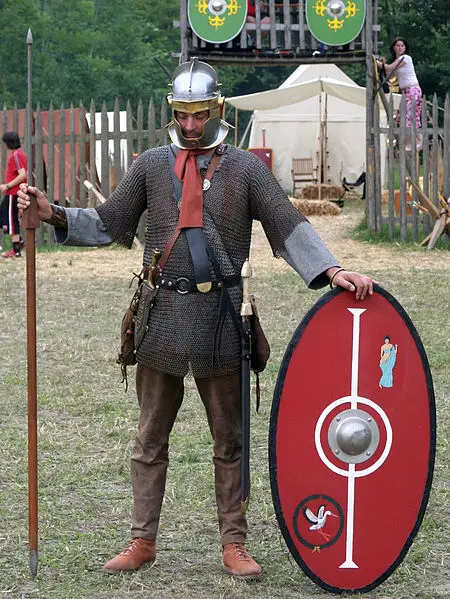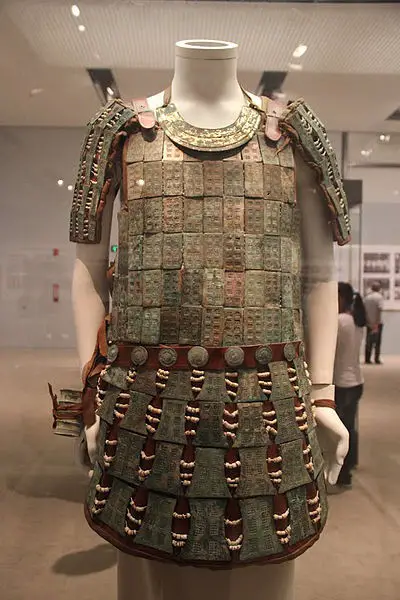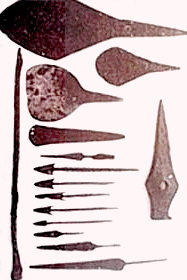The prehistory of humanity is divided into three major periods which are the Stone Age, Bronze Age, and Iron Age. Iron Age is the last among these periods. Students who love to study these ages are also interested in the Tools and Weapons used by the people of these ages. Here we have gathered complete information about Iron Age Tools And Weapons which will provide all the Iron Age Tools information the students need to know. You are going to learn iron age tools facts, tools names and uses, images, history, how they were made, types, blacksmith tools, cooking tools, agricultural tools, flint tools, hunting tools, mining tools, inventions and technology, iron age tools of Britain, India, and Africa, iron age weapons facts, names, history, iron age weapons from Britain, Germanic and Irish, projectile weapons, spears, swords, armors and much other interesting information about the Iron Age tools.
Iron Age Tools And Weapons
1. Iron Age Tools Facts – Facts About The Iron Age Tools
- The Iron Age is the period of prehistory that came after the Bronze Age.
- The iron Age started between 1200 and 600 BC in different regions of the world.
- During this period, people began the formation of tools and weapons from iron and steel.
- Iron was tougher than bronze, so the people of the Iron Age became capable to make sharp tools like swords and spears.
- They also made harvesting tools from iron, such as plow (Ard) and sickles.
- Iron is one of the few substances that left indelible marks on civilization. Iron tools played a wide role in the development of cultures and societies and the establishment of kingdoms.

2. Iron Age Tools List – Iron Age Tools Names – List Of Iron Age Tools
- The following is a list of some major Iron Age tools:
- Ard
- Iron sickles
- Coulter
- Plowshare
- Swords
- Lances
- Spear
- Rotary quern
- Potters Wheel
- Wood lathe
- Iron rudder
- Iron chisel
3. Iron Age Tools And Uses
| Tool Name | Uses |
| Ard | Ard was a scratch plow with the pointed iron tip |
| Iron sickles | A tool for harvesting crops |
| Coulter | An iron-made farming tool used for breaking the ground |
| Plowshare | A farming tool used for making uniform rows in the field |
| Swords | The iron made sword was an efficient weapon |
| Lances and spears | Long wooden weapons with iron tips |
| Rotary quern | A machine for grinding grains |
| Potters Wheel | Wheel for making pottery |
| Wood lathe | A machine like structure for shaping wood and other things into objects |
| Iron rudder | The rudder was used on the ship to make it steer on its own |
| Iron chisel | A tool used for cutting wood, stones, metals, and other hard things |
5. Iron Age Tools History – Early Iron Age Tools
- The Iron Age followed the Stone Age, the Copper Age, and Bronze Age and started about 1,500 BC.
- The discovery of limonite (a mineral made up of a mixture of hydrous ferric oxides) make smithery possible.
- The formation of tools from iron started in Anatolia, present-day Turkey.
- As iron was powerful and tougher than bronze, it enabled people to make objects with strong and sharp edges.
- During the Early Iron Ages (1,200 BC) Iron swords appear. However, such swords became popular and widespread in the 8th Century BCE.
- The history of spears dates back to about the 7th century BCE. The Hoplites (citizen-soldiers in the city-states of Ancient Greek) were probably the first people who were armed with spears.
- Sickle made up of iron is mentioned in the book of Pliny the Elder, “Natural History”. In his book, he describes the “Ritual of oak and mistletoe”, which was performed with the iron made sickle by the Druid Celtic people in about 50 BCE.
- Celts were probably the first people who used Ard for farming.
- The history of the Iron Age rotary querns dates back to about 400 BCE.
6. How Iron Age Tools Were Made – How Were Iron Age Tools Made
- In the Iron Age, tools from the iron were made by heating the iron at extreme temperatures.
- They probably used charcoal fire as a source of heat.
- As iron is harder and has much more melting point than bronze, it was impossible to use pouring into the mold method for making tools.
- So probably, they had to heat iron until it glowed and then hammered into the shape of the desired object before cooling. This process is known as forging.
- They would have reduced the brittleness of the metal through the reheating of quenched iron into a medium temperature and then allowing its slow cooling.
7. Types Of Iron Age Tools
- People in the Iron Age used iron to produce two types of tools:
- Agricultural or farming tools
- Weapons
- However, there are also some discovered metallic cooking tools, coins, ornamental tools, and jewelry that belongs to the Iron Age.
8. Iron Age Blacksmith Tools – Iron Age Metalworking Tools
- In the Iron Age, blacksmiths would have used three basic tools for making objects from iron.
- Those tools were:
Hammar
- In Britain, about thirty hammerheads were discovered, most of which belong to the Iron Age (1 century BC).
- The metallography of those hammerheads indicates that many of them are quenched hardened at one or both sides, while some may have been tempered to achieve greater toughness.
Anvil
- An anvil is a heavy iron block used for hammering and shaping metal.
- The Iron Age anvils were probably stone blocks.
- On the Orkney Island of Rousy, Scotland, an archeological discovery revealed the remains of an Iron Age smith’s workshop.
- There were two stone anvils and the larger one had the carbon imprints of hands and knees of the smith.
Tong
- Tong is a rod or pillar-like structure for holding hot metal.
9. Iron Age Cooking Tools
- The cooking tools of the Iron Age included pots that were made through the wheel throwing method.
- Cauldrons of metal were also probably used for the boiling of meat as well as for heating alcoholic drinks.
- Such vessels were made from copper-alloy with a rim and handles of iron to enhance rigidity and strength.
10. Iron Age Agriculture Tools – Iron Age Farming Tools – Iron Age Tools For Farming
The following were some of the Iron Age farming or agriculture tools:
- Ard was a wooden tool with an iron tip for breaking the ground. It was used to make only simple channels or lines for sowing the seed.
- Plows were large wooden and iron farming tools of Celts. It was pulled by animals or humans. It had two basic functional parts;
- Coulter, which was a vertical cutting blade of iron fixed in the front region of the plow for breaking the ground.
- Plowshare was an iron blade at the back of coulter. It was the tool for making uniform rows in the ground for planting.
- The Sickle was made up of iron at the start of the Iron Age and then later of steel. It was used for harvesting crops and for cutting grass and tree branches.

11. Iron Age Flint Tools
- Flint is a hard form of sedimentary rock, which is made up of mineral quartz.
- In prehistory, it was used for making stone tools and other special fire-making tools.
- According to some archeological views, flint work disappeared at the end of the Bronze Age.
- Some archeologists believe that flint working during the Iron Age was fiction.
- While some argue that flint was regularly used during the Late Bronze Age and Iron Age.
- In England, archeologists discovered flint tools and blades that belonged to the Iron Age at a site under the Surrey fire station.
- Despite all the arguments, archeologists agree that flint was used as a fire-making tool in the Iron Age.
12. Iron Age Hunting Tools
- Iron Age weapons were also used as hunting tools.
- The swords, daggers, lances, and spears were probably used for hunting.
13. Iron Age Iron Tools
- The Iron Age iron tools were:
- Ard
- Iron sickle
- Iron chisel
- Sword blades
- Iron spearheads and lancehead
- Iron daggers
- Iron armors
- Iron seals
14. Iron Age Mining Tools
- In the Iron Age, they simply used digging tools for small-scale mining, however, some techniques were used for large-scale mining. Such as:
Fire-setting
- Diodorus Siculus described the use of a fire-setting mining method for mining gold in Ancient Egypt in his Bibliotheca Historica, which he wrote about 46 BC.
- It was the most common traditional method of mining in the Iron age.
- In this method, they might set a fire against a rock face.
- After heating the rock till at an appropriate temperature, it would be doused with liquid.
- The rapid cooling would cause a thermal shock and the brittleness of rock ledges and causing it to easily crack with digging tools.
- This technique was possibly performed for surface mining, as it was extremely dangerous for underground mining without proper ventilation.
Hydraulic Mining or Hushing
- This method of mining was originally used by ancient Romans during the 1st century BC and the 1st century AD.
- In this method, they used floods or fast-moving streams of water to reveal the veins or sheets of minerals.
- This method was applied not only to searching mineral deposits but also for their exploitation.
15. Iron Age Stone Tools
- In the Iron Age, the stone tools were used for building underground chambers, structures above the ground, and for other activities in the completed structures.
- The stone tools were also used for grinding. For example quern rubbers and saddle, querns were discovered at High Pasture Cave, Skye, Scotland, dating back to the early Iron Age.
- Stones were also used as cobble tools.
16. The Iron Age Tools, Inventions, And Technology
- With the discovery of iron around 1,600 BC, tools were made from iron, inventions occurred, and technologies were introduced.
- Some of the Iron Age inventions and technologies are the following:
Improvement of Farming Tools
- Farming tools were improved and the simple wooden plow was replaced with an iron-tipped plow (Ard). It made agriculture easier and resulted in a high yield of crops.
Wood Pole Lathe
- The invention of the Wood Pole Lathe allowed the woodworkers to make more practical and useful items from wood, such as bowls and buckets. The earliest known representation is a wall relief art carved in stone in the tomb of Petosiris in Egypt, which dates back to about 330 BC.
Rotary Quern
- British started the use of rotary quern around 400-300 BC. It was a domestic tool for grinding grains and was made up of two circular quern stones. The upper stone had a handle and was movable in a circular direction around an axel while the lower stone was immoveable.
Potter’s Wheel
- The technology of wheel thrown-pottery was developed around 4500 BC. It made the pottery-making process easy and fast.
Ships
- During the 1st century AD, the people of the Nusantara archipelago made about 50 meters large ships that could stand 4 to 7 meters out of water. The ships could carry more than 700 people and up to 250-ton cargo. Tanja sails were used in the ships, due to which it could sail against the wind direction.
The Alphabet
- Between 800 and 700 BC, the ancient Egyptians invented the alphabet, which made communication easier.
Development of Coloring Agents
- During the Iron Age, red, blue, and yellow were the three major colors. They used the roots of madar plant for the production of red color. The blue color was derived from wood and the yellow color was obtained from the weld. Plants were immersed in hot water and the wool was then soaked in the dye bath. For fixing dyes, the Iron Age people may have used stale urine as a dye fixative or mordant.
17. Iron Age Britain Tools
- The following are some of the tools used in Britain during the Iron Age:
- Iron-tipped plow (Scratch plow or Ard)
- Iron sickles
- Coins (the earliest coins discovered in Britain dates back to the 2nd century BC, and are made up of iron or bronze)
- Wheel-thrown pottery
- Iron swords
- Wandsworth shield (a shield made up of bronze discovered from River Thomas (London) that dates back to the 2nd century BC)
- The Battersea shield (an important masterpiece of Celtic art also discovered from River Thomas. It is an Iron Age wooden shield with bronze covering dating back to 350 to 50 BC)
- The waterloo helmet (a horned helmet made up of copper alloy discovered from River Thomas and dates back to 150 to 50 BC)
- The Great Torc from Snettisham (an Iron Age large gold torc or neck ring created during 70 BC)
18. Iron Age Tools In India
- In the Indian subcontinent, the discovered Iron Age tools are mainly associated with:
The Vedic Period (ca. 1500-600 BCE)
- Tools of this period include the ceramic tools of various designs and weapons made up of metal.
- An antenna sword of the Vedic Period had been discovered, which dates back 1500-500 BCE, while a discovered ax blade of this period dates back 1500-1000 BCE.
Painted Grey Ware Culture (1200-600 BCE)
- Tools of the Painted Grey Ware culture include grey and fine pottery of remarkable styles painted with geometric patterns of black color, ivory working tools, and tools made through iron metallurgy. Other tools include plows, stamp seals, carpentry tools, and war weapons.
Northern Black Polish Ware (700-200 BCE)
- It is believed that the people of Northern Black Polish Ware culture developed high firing techniques used for smelting iron and making tools from the local hematite soil (soil that has iron oxide).
- The discovered tools of this period include stylish burnished pottery, punch-marked coins, inscribed stamp seals, agriculture tools, and weapons.
Second Urbanization (ca. 500-200 BCE)
- Tools associated with this period are agriculture tools and weapons made of iron, metals coins, and art crafts of ivory, precious stones, and gold.
- High-quality steel, known as Wootz steel, also developed during this period in Southern India. Its tools were later exported to Arabia and China.
19. African Iron Age Tools
- The African Iron Age tools are of two basic categories:

Agriculture Tools and pottery
- The agriculture tools of iron widely changed societies throughout Africa.
- The iron tools used for agriculture were more efficient to make the toughest soil workable for agriculture, so societies and agriculture communities flourished with the use of iron tools.
- The agriculture tools were the iron plow, iron sickles, axes with an iron head, iron shovel, etc.
- People across Africa also made pottery of characteristic types; metals and ceramics.
Weapons
- The iron weapons included swords, knives, spears, and daggers.
20. Iron Age Weapons Facts – Iron Age Weapons Information
- The most common weapons in the Iron Age were swords, spears, axes, and shields.
- It is revealed from the Iron Age tombs of the men that the princes and noble state persons were armed with bronze armor and helmet, a shield, and iron made attacking weapons; an ax or sword and spear.
- The swords of the Iron Age were short and were much like a large daggers. It usually had a cover sheet and hung across the chest or back.
- They also used projectile weapons such as spears and javelins to attack the enemy from long distances.
- The archeological evidence shows that there was widespread use of chariots in the wars during the Iron Age. Chariots were used to quickly move the heavily armed warriors to the battlefield.
- The weapons of the Iron Age warriors were buried along with their dead bodies, while the princes and other noblemen were buried along with their weapons as well as horses.
21. List Of Iron Age Weapons
- The following is a list of some Iron Age weapons:
- Swords
- Ax
- Daggers
- Knives
- Spears
- Lances
- Javelins
- Shields
22. Iron Age Weapons History – Early Iron Age Weapons
- The first Iron made swords appeared around the 12th century BC during the Early Iron Age, however, they became widespread during the 8th century BC.
- In the West, short daggers took the place of swords during 600 and 500 BC.
- In 1925, the dagger of Tutankhamen (14th Century BC) was discovered in his tomb in the King’s Valley, Egypt. The dagger’s blade has a meteoric composition and has mostly iron, about 11% Nickel, and about 0.6% Cobalt.
- The spear is mentioned in the “Iliad” (an ancient Greek epic poem written by Homer and composed at the end of the 8th century BC or the start of the 7th century BC). In the poem, the events of the Trojan war are described in which spears were the basic weapons of the warriors.
- Lances, spears, and shield weapons became more standardized during the 3rd and 4th centuries AD.
- Bowmen became an essential part of the Army’s infantry during the 3rd century AD.
23. British Iron Age Weapons – Iron Age Weapons Britain
- The common weapons in Britain during the Iron Age were:
- Swords
- Daggers
- Spears
- Shields
24. Germanic Iron Age Weapons
- The term “Germanic” is used by many people in Northern and Central Europe, including the Cimbri, Franks, Frisians, Saxons, Alemanni, Suebi, and Averni.
- The most common and effective Iron Age weapon of Germanic people was a spear. They were famous for fighting with spears.
- The club was another basic weapon Germanic people used during the Iron Age. It was extremely effective in breaking the helmet and armor of the enemy.
- They were taught and skilled with slingshots, which was their formidable weapon to hit the target from a long distance.
- The javelin was another weapon of Germanic people to assault from a distance, particularly in forests.

25. Irish Iron Age Weapons
- Around 500 BC, the Celts arrived in Ireland and probably brought the iron tools and weapons to Ireland.
- So, the Iron Age weapons in Ireland were mostly those used by Celts.
- The common weapons were:
- Swords
- Spears
- Daggers
- Shields
Iron Age Celtic Weapons – Iron Age Celts Weapons
- The Iron Age Celtic weapons included:
- A long sword made of iron was the deadliest weapon of a Celtic warrior
- Daggers made of iron
- Spears with iron tips
- Iron javelins were the projectile weapons the Celtic warriors used
- Shields of an oval shape
26. Iron Age Projectile Weapons
- Spears and javelins were the projectile weapons of the Iron Age.
- These weapons had an iron tip attached with a shaft of wood.
- Germanic people were also skilled in using slingshots.
- The projectile weapons were effective for attacking the enemy from a long distance.
- The bows and arches appeared in the later Iron Age, and the men using it were an essential part of the infantry.
27. Spears Iron Age Weapons
- The use of spear has been described in Homer’s epic poem “Iliad” written around the 8th century BC. Two types of spears are mentioned in the poem; a single-headed spear and a two-headed spear.
- In the 7th century BC, the hoplites (the citizen-soldier in ancient Greek) were equipped with spears that had a head of iron and a butt-spike (doru) of bronze.
- In the 4th century BC, the Peltasts used spears and javelins. At around that time, the sarissa was developed in Macedonia. It was a long spear of 4 to 6 meters in length.
- In the 2nd century BC, all the professional infantrymen of the Roman army were equipped with pilum. A pilum was about a 2-meter long javelin with about a 24-inch iron shank.
28. Swords Iron Age Weapons
- The Early Iron Age swords were work-hardened and only slightly better than the earlier bronze swords. A further innovation was made when the smiths learned that the addition of a small amount of carbon to iron could produce a much better alloy (steel).
- Before 600-500 BC, the iron swords were of long shapes which were then replaced with short daggers.
- Around the 6th century BC, the Scythian/Persians made Acinaces from iron, which had the shape of a large dagger or short sword.
- The Roman gladius and Greek xiphos were also short swords of the Iron Age.
- In China, iron swords are known from the period of the Zhou dynasty (1046 to 771 BC). However, the steel swords appeared from the 5th century BC during the Warring State Period.

29. Iron Age Armors
- Two types of armors were used in the Iron Age:
Chain Armor or Chain Mail
- Celts are credited for the invention of chain armor. However, examples of Etruscan pattern armor exist that dates back to about the 4th century BC.
- The earliest surviving chain armors were discovered in the Carpathian Basin at the burial of a chieftain (tribal chief) in Ciumesti, Romania, and in a grave in Horny Jatov, Slovakia. Both date back to the 3rd century BC.

Scale Armor or Scale Mail
- It is the earliest form of armor made up of many individual small plates or scales attached in overlapping rows to each other or a leather or cloth.
- The material of scales varied at different times and included bronze, iron, steel, lather, raw animal skin, horn, seeds, and pangolin scales.
- The use of scale armor may have started in the Middle East. The tomb of Kenamon, who lived during the reign of Amenhotep Ⅱ (1436 – 1411 BC) in Egypt represents the earliest scale armor.
- Lorica Squamata was a type of scale armor the ancient Roman military used in the Roman Republic from 509 to 27 BC.

30. Bronze Age Vs Iron Age Weapons
- The Bronze Age weapons were weaker and less effective than the Iron Age weapons. As bronze is a much softer material than iron.
- Due to softness, it was impossible to make sharp edges of the bronze weapons. On the other hand, iron weapons were much harder and capable to sustain sharp edges.
- As compared to bronze, iron is a widely available metal on the earth’s crust, so it was easy during the Iron Age to obtain a weapon. While the weapons were not in the access of everybody during the Bronze Age.





